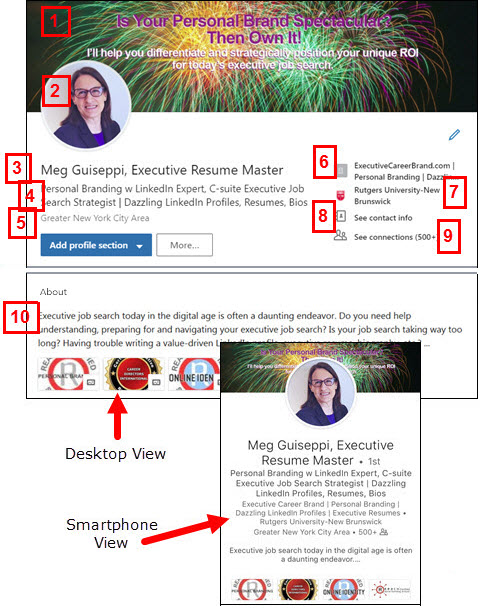
You have a “brand” new resume aligning your unique set of qualifications with the needs of your well-researched target employers, and differentiating your value proposition (or personal brand) from your competitors in the job market.
Don’t stop there.
A great resume is not enough any more to land your next great gig.
You’ll need a strong, on-brand online presence so recruiters and hiring decision makers, searching for and assessing candidates like you, will find plenty of diverse information about you.
Start with LinkedIn – the most important social network for any job seeker, but especially for executive job seekers.
Advertisement
Many savvy executives competing for the jobs you want have already embraced all that LinkedIn has to offer. Even if you don’t use all of LinkedIn’s features, you should have a great Profile there, just to keep pace with your competition.
Recruiters and other hiring authorities routinely search LinkedIn for viable candidates, and even have special applications designed for that purpose.
If they don’t find you on LinkedIn, they may not find you at all. And if they do find you elsewhere, they may wonder why you’re not on LinkedIn.
They may wonder whether you’re up-to-date and social media-savvy.
Create Your Winning LinkedIn Profile
Merely throwing together your LinkedIn Profile without strategizing its impact on your target audience may render it ineffectual or even a detriment to you.
Strive to get your profile up to LinkedIn’s “All Star” status, if you’re not there already. Check your Profile Strength Meter to see how strong your profile is. In “View profile” mode, look for the meter below your top card information, which includes your photo, name, headline, etc.
If you hover your cursor over the meter, you’ll see how far you’ve come in profile strength. When you click the drop down icon in the meter, you’ll find out how to move to the next step in strength. When you’ve completed all the steps, the meter is replaced with the All-Star image shown here.
Recruiters and hiring authorities search for candidates on LinkedIn using keywords relevant to the skill sets and qualifications they’re looking for in people.
To be more findable to them, your LinkedIn profile needs to contain the right keywords and phrases, positioned in the right way, so that your Profile lands high in search results for those keywords.
Once these people land on your Profile, it needs to immediately capture and hold their attention, and brand your potential value to them.
(See Job-Hunt’s Guide to LinkedIn SEO for more details on finding and appropriately placing your best keywords.)
Tips by LinkedIn Section
Here are some tips, working down through the various sections, as they stack up at this writing.
The Boxes at the Top of Each Profile (or Your “Introduction Card”)
Whether someone is using a computer or a smartphone, this is the first section visible when someone visits your Profile page, so this is the part of your Profile that will be seen most often.
As you can see in the images below, the smartphone view is similar to the desktop view, but not exactly the same. Viewers will see many, but not all, of the same elements in their smartphones as they do on their computer.

Your photo, name and headline are sometimes visible to people elsewhere on LinkedIn, as when they hover over your photo and name accompanying your comments, likes and shares.
The numbers below correspond to the numbers in the images above. Except for number 8, all of the elements are visible in both views of your Profile’s Introduction Card.
-
Billboard
Create a billboard (the column-wide space behind your Profile photo at the top of the page) with an image and/or content that supports your personal brand as the background for the top of your Profile.
-
Photo
Choose your photo wisely. This is the first thing people are likely to see when they open your LinkedIn Profile. Go with an appealing photo that strikes the right image and professional tone for your industry and niche.
Use the same photo everywhere else online, so people can easily identify you.
Why is it important to include a photo? It helps generate an emotional connection. For more about this, see my article on branding your online photo.
-
Name
Use the version of your name that you use on your business cards and resumes. (See Your Most Important Keywords.)
Add any relevant certifications after your last name here to boost SEO. -
Professional Headline
This is directly below your name.
Pump it up with the relevant key words your target audience will be looking for. You can pack quite a punch with the 120 characters allowed.
Which of these headlines, for the same executive, do you think will make her Profile more searchable and compelling?
CEO – [Current Company]
OR
CEO – Global Operations Change Agent | Entrepreneurial Startups | Crisis, Recovery & Turnaround Management
The first example is the default headline LinkedIn will give you, based on the information you’ve completed for your most recent job, if you make no changes.
[More: How to Double (or Triple) Your LinkedIn Visitor Traffic with Keywords.]
-
Location
Location is an important section for recruiters and others who might want to connect or contact you based on where you are located. Based on the Zip Code you provide in this section, LinkedIn will offer location name options.
-
Most Recent Job
Although unlabeled in your Profile, LinkedIn will pick up the job title for the job you list first in the Experience section. Add relevant keywords and keyword phrases to your job titles and to your employer’s name, as space allows, to boost SEO.
-
Most Recent Education
Also unlabeled, LinkedIn will pick up this information from what you enter as the most recent school from the Education section further down your profile.
-
See Contact Info
LinkedIn offers important options for adding more branded content. This section is lower in the smartphone view of your Profile.
Customize your LinkedIn URL. At a minimum, remove the numbers LinkedIn includes for unaccustomed URLs which typically look like this — /in/mary-smith-915223147/ — before being edited. After editing, it could be /in/mary-smith (if that is available).
If someone else already has your ideal URL, consider a different version of your name like /in/mary-j-smith, /in/mary-jane-smith, or (if appropriate) /in/mary-smith-mba or /in/mary-smith-accountant. Do not include a number which might look like a birth year, for example, /in/mary-smith-81.
Include links to up to 3 web pages. If you don’t have a blog or website, this is a great place to put a link to your online career portfolio, any notable press about you, a white paper you published online, etc.
If you’re actively participating in a professional manner on other social media (Twitter, Facebook, Instagram, etc.), include a link to your profile(s). The idea is to lead people to more brand-reinforcing information about you.
Very Important!!! Include your personal email address here. Make it very easy for people to get in touch with you! (See Be Reachable to Be Hired for more details on safely making contact information visible on your Profile.)
-
Connections
Opinions differ on whether it’s more important to amass a lot of connections or concentrate on building quality connections. Best strategy is to try to do both.
Profiles with 500 or more connections land higher in search results than those with fewer than 500. Build up your LinkedIn network to open yourself to more opportunities, but also be sure to connect with people you already know.
-
About (formerly Summary)
It’s better not to just copy and paste the top part of your resume (or professional summary) here. Generate chemistry in the About section by showcasing your personality and linking your “softer” skills with your functional areas of expertise (which represent relevant keywords).
Let people know right away what differentiates you from your competition. If you have a bio, you can use some information from that.
You’re allowed 2,000 characters in this section. The first 3 lines of the About section are visible on computer screens and the first 20 to 40 words are visible on smartphone screens without clicking on the “Show more” link, so focus on making those words a strong branding statement.
Try your best to use all 2,000 characters. More content = more relevant keywords = better potential for being found.
(See Personal Branding Makes Your LinkedIn Summary Dazzle for more details.)
Articles & Activity
This section is below Your Dashboard and will appear only if you post updates and/or publish articles on the Pulse platform. Click on the “Home” button at the top of your Profile to add content.
On your Home page, you’ll see the query “Share an article, photo, video or idea,” beside your headline and photo.
Regularly posting updates (say, every week or at least a few times a month) keeps you and your brand top of mind with your network. Updates also represent another opportunity to brand your Profile with relevant key words. Include a link to more about the update, if possible.
(See Keep Your Personal Brand Top-of-Mind with Your LinkedIn Updates for more details.)
Experience
For each job, pump up this section with more details than you could fit in your resume. LinkedIn gives you plenty of space (2,000 characters for each job) to provide more brand-reinforcing, keyword-rich content here for each of your jobs.
(See Top 25 Keywords for You in Your Job Search for ideas about what to include.)
Education
You can copy and paste this information from your resume.
Skills & Endorsements
Pull together a list of your top 50 skills (or areas of expertise), and post them to your Profile in order of importance to your target employers. Then you can reach out to your connections individually and ask them to endorse you to build up your numbers. And you’ll see others you haven’t asked add endorsements to your Profile.
LinkedIn lets you reorder and delete skills. Come back, say, every few months or so, and repeat to keep this section up to date.
(See 4 Steps to Leverage LinkedIn Skills & Endorsements for a More Powerful Profile for more details.)
Recommendations
Keep building up brand and value-reinforcing recommendations within each job you’ve held. Nothing speaks to your unique value proposition better than what others who know your work best have to say about you.
If they’re amenable, it’s okay to help them write a brief paragraph or two by providing them a little information about the kinds of positions you’re seeking, so that they can align what they write with what hiring decision makers will be looking for.
Interests (LinkedIn Groups)
As you join LinkedIn Groups, this section will fill out. A very powerful LinkedIn feature, Groups help you uncover new networking opportunities, reconnect with your neglected network, demonstrate your subject matter expertise, connect with people at your target companies, and potentially land your next job or business opportunity.
Accomplishments
Fill out all applicable sections.
Some General Tips:
- Pay special attention to all that is visible “above the fold” in your Profile — whatever is on the screen when you open your Profile. This is what people will see first, and can make or break your chances to be considered. Capture their attention and make them want to scroll down to read your entire Profile.
- Include a link to your LinkedIn Profile on your resume, along with your contact information at the top. Include a nifty LinkedIn badge in your email signature, on your blog, website, and elsewhere.
The Bottom Line:
These tips will help you extend the value of your branded resume and bio, while building your online presence and brand reputation. If all of this is beyond your capabilities, consider working with a professional job search strategist who knows how to leverage these tools to best position your unique value proposition.
More About Leveraging LinkedIn
- Guide to Personal Branding with LinkedIn
- 5 Essential Elements of Effective Personal Branding for Your LinkedIn Profile
- Personal Branding with Your C-A-R Stories
- The Absolute Best Practices for Building Your Personal Brand with LinkedIn
- Make Your LinkedIn Summary Dazzle with Personal Branding
- 3 LinkedIn Personal Branding Mistakes
- Guide to LinkedIn SEO
 About the author…
About the author…
Meg Guiseppi, Job-Hunt’s Personal Branding Expert and 20+ year careers industry veteran, has earned 10 certifications, including Reach Certified Personal Branding Strategist, Reach Social Branding Analyst – LinkedIn Profile Strategist, and Certified Executive Resume Master. Meg is the author of “23 Ways You Sabotage Your Executive Job Search and How Your Brand Will Help You Land.” Connect with Meg at ExecutiveCareerBrand.com for c-suite personal branding and executive job search help and on Twitter (@MegGuiseppi). And, you may also download Meg’s free ebook – Job-Hunt Guide to Smart Personal Branding with LinkedIn.
More about this author…
Don't forget to share this article with friends!




